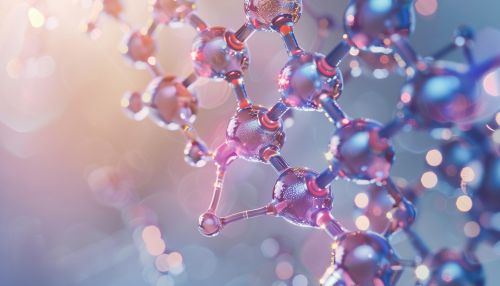Acetyl-CoA
Overview
Acetyl coenzyme A, often referred to as Acetyl-CoA, is a crucial molecule in biochemistry. It plays a significant role in many biochemical reactions, particularly in protein, carbohydrate, and lipid metabolism. Acetyl-CoA is derived from pyruvate, a product of glycolysis, and is a key component in the citric acid cycle, also known as the Krebs cycle or TCA cycle.
Structure
Acetyl-CoA is composed of an acetyl group attached to coenzyme A (CoA). The acetyl group consists of a methyl group single-bonded to a carbonyl. The carbonyl is connected to the sulfur atom of CoA via a thioester bond. This bond is high-energy and its hydrolysis is exergonic, which makes acetyl-CoA an excellent group transfer molecule.
Biosynthesis
Acetyl-CoA is primarily synthesized from pyruvate, a three-carbon molecule that is the end product of glycolysis. This process, known as pyruvate decarboxylation, is catalyzed by the enzyme complex pyruvate dehydrogenase. During this reaction, one molecule of carbon dioxide is released, and one molecule of NADH is produced. The resulting two-carbon molecule, now in the form of acetyl-CoA, is then ready to enter the citric acid cycle.


Role in Metabolism
Acetyl-CoA plays a central role in metabolism, acting as a key intermediate in a variety of metabolic pathways.
Citric Acid Cycle
In the citric acid cycle, acetyl-CoA combines with a four-carbon molecule, oxaloacetate, to form a six-carbon molecule, citrate. This reaction is catalyzed by the enzyme citrate synthase. The citric acid cycle is a series of chemical reactions used by all aerobic organisms to generate energy through the oxidation of acetyl-CoA.
Fatty Acid Synthesis
Acetyl-CoA is also a central molecule in the synthesis of fatty acids. The process begins with the carboxylation of acetyl-CoA to form malonyl-CoA, a reaction that is catalyzed by the enzyme acetyl-CoA carboxylase. This is the first and rate-limiting step of fatty acid synthesis.
Amino Acid Metabolism
In amino acid metabolism, acetyl-CoA is involved in the breakdown of certain amino acids. These amino acids undergo transamination reactions to form corresponding keto acids. The keto acids can then be decarboxylated to form acetyl-CoA.
Regulation
The concentration of acetyl-CoA within the cell is tightly regulated, as it influences many metabolic pathways. Key regulatory mechanisms include allosteric regulation of the enzymes involved in its synthesis and degradation, as well as the availability of substrates and cofactors.
Clinical Significance
Abnormalities in acetyl-CoA metabolism can lead to a variety of metabolic disorders. For example, deficiencies in pyruvate dehydrogenase can lead to lactic acidosis and neurological dysfunction. Additionally, alterations in acetyl-CoA levels have been implicated in neurodegenerative diseases such as Alzheimer's disease and Parkinson's disease.
